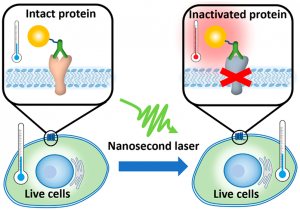Customer Spotlight- Dr. Zhenpeng Qin- UT Dallas
Background: Dr. Zhenpeng Qin Ph.D. is an Assistant Professor of Mechanical Engineering at UT Dallas and runs the Nano-Thermal Bioengineering Laboratory (NT-BEL). The NT-BEL team focuses on increasing the fundamental understanding of brain bio transport issues and developing nanotechnology-based approaches to better understand the brain.
Exciting Recent Work
Dr. Qin and colleagues recently published an article in ACS Nano entitled “Transient Photoinactivation of Cell Membrane Protein Activity without genetic Modification by Molecular Hyperthermia”. Using a MagicPRISM NIR from OPOTEK, the team was able to demonstrate the value of heating gold nanoparticles (AuNP) with nanosecond laser light to photo inactivate proteins without affecting the surrounding cells.
Qin et al demonstrated this with two proteins. The first is the protease-activated receptor 2 (PAR2) which, when activated, causes pain sensitization. Using a specific wavelength of nano pulsed laser light on antibody conjugated AuNPs, they were able to inactivate 2(PAR2) in situ. The resulting protein deactivation was confirmed when there was no measurable Ca2+ signal across the cell membrane to start the pain sensitization cascade.
The second protein discussed in the paper is JAM-A, a tight junction protein in brain endothelial monolayers. Tight junction proteins are an integral part of the blood-brain barrier (BBB) which protects our brains from invading viruses and microbes, but which also prevents many therapeutics- especially larger biologics- from entering the brain. Dr. Qin’s group demonstrated that they could inactivate this protein, causing a reversible (6 hr) BBB opening in vitro.
 Both findings have exciting implications for therapeutic innovation as well as increasing our understanding of the function of these proteins. This work opens avenues to develop therapeutics with high spatiotemporal resolution for the chronic pain associated with 2(PAR2) activation as well as offering a promising way to enhance drug delivery to the brain by inactivating JAM-A.
Both findings have exciting implications for therapeutic innovation as well as increasing our understanding of the function of these proteins. This work opens avenues to develop therapeutics with high spatiotemporal resolution for the chronic pain associated with 2(PAR2) activation as well as offering a promising way to enhance drug delivery to the brain by inactivating JAM-A.
Q&A With Dr. Qin
What attracted you to your field of study?
I am always fascinated by what we can do with light in medicine. Using light to manipulate protein activity in living systems opens up various biomedical opportunities. The fascinating part of our study is we do not rely on genetic modification to enable the photosensitivity of the living system. This gives us the flexibility to further develop our method as a useful therapeutic tool for human disease treatment.
What outcomes would you like to see as a result of your work?
Although there is a long journey ahead, ultimately, I would like to see our method applied to patients and used to treat diseases in real life; things such as chronic pain or neurological disorders. The necessary step toward this goal is to test our method in vivo.
How has the OPOTEK MagicPRISM NIR been helpful in your research?
To accomplish this, we need to deliver light to deep tissue. MagicPRISM NIR provides us nanosecond laser source in the near-infrared range which has deeper tissue penetration than visible light. Moreover, the laser wavelength can be tuned from 690-950 nm with a stable fluence output. This wide choice range of wavelength brings us flexibility when we design and synthesize nanostructures.




